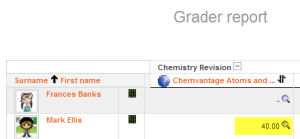|
|
| (20 intermediate revisions by 7 users not shown) |
| Line 1: |
Line 1: |
| | {{LTI External tools}} |
| | This page explores how to use [[LTI External tools]] in your course as activities. |
|
| |
|
| {{External tool}}
| | ==How is it set up?== |
| This page explores in more detail the settings for the [[External tool]] once you have added it to your course and also covers the Site administration settings.
| | To create an activity using an LTI External tool, go to the Course page and turn on Edit mode. Click either the link ‘Add an activity or resource’ at the bottom of each section, or click anywhere on the course page where you want to add your item. The Activity chooser will show; then, select the tool you want to create an activity with. |
| ==General==
| |
|
| |
|
| *'''Activity name''' - add a title, description if required, with your choice of display.
| | If the tool you want to use is not in the Activity chooser, you need to toggle the 'Show in activity chooser' option in the table in Course page > More > LTI External tools. This page is also where you can see all LTI External tools available in your course. For more information, see [[Managing LTI External tools]]. |
| *'''Preconfigured tool''' - this is how Moodle communicates with the tool provider. If in doubt, leave as default. If your administrator has made a tool available site-wide, you will be able to select it here:
| |
|
| |
|
| [[File:Preconfiguredtool.png|center]]
| | Once you select the tool in the Activity chooser, you can continue with activity creation and select the settings you'd like. |
| | === General === |
| | ===== Content ===== |
| | If you're using a tool that supports deep linking, you will see a 'Select content' button on top of the activity form. Use this button to select which specific content from the tool you want to use in your activity. |
|
| |
|
| *'Select content' button - allows to import the link definition from the tool rather than entering it manually. This is the preferred flow when available.
| | Once you select content, the Activity name and Activity description might be automatically populated by the tool. |
| *'''Tool URL''' - This is the URL for connecting to site. If your moodle site uses [https://en.wikipedia.org/wiki/Transport_Layer_Security SSL] (is on [[HTTPS]]) you will only be able to use a tool that also uses [https://en.wikipedia.org/wiki/Transport_Layer_Security SSL]. Make sure the tool URL has [[HTTPS]] before attempting to use it or you may get a blank page.
| |
| *'''Launch container'''- this is how the external tool will be displayed.
| |
| **Default - if in doubt; leave as default
| |
| **Embed - the external tool will be embedded in the Moodle course page with blocks and navigation bar
| |
| **Embed without blocks - the external tool will be embedded in the Moodle course page but without blocks
| |
| **New Window - the external tool will open in a new window. (A new window or tab will open with the External tool and the old browser window containing the course page will not change.)
| |
|
| |
|
| ''The following settings are available by clicking ""Show more":''
| | If not, give your activity a name and, optionally, a description. |
| *'''Activity description''' - give a short description here
| | ===== Display activity name when students access the tool ===== |
| *'''Display description on course page''' - choose to show the description along with the activity name
| | You will only see this setting if your site uses the Classic theme and, in the tool settings, the tool’s content display has been configured as ‘Embed’ or ‘Embed, without blocks’. |
| *'''Display activity name when launched''' - have this appear when the student clicks the link.
| |
| *'''Display activity description when launched''' - have this appear when the student clicks the link.
| |
| *'''Secure tool URL''' - This overrides the tool URL when moodle uses [https://en.wikipedia.org/wiki/Transport_Layer_Security SSL] (if your site is configured to use [[HTTPS]] in the wwwroot)
| |
| *'''Consumer key''' -this tells the connecting LTI compliant site that your Moodle is allowed to connect. The "tool provider", ie the manger of the connecting LTI compliant site will issue you with this key. If you are merely linking to a tool with no secure access or gradebook sharing then you won't need a consumer key. If you are linking to a course or activity from another Moodle site, then you can add any consumer key.
| |
| *'''Shared secret''' - this is the "password" to connect to the tool - the LTI compliant site.
| |
| *'''Custom parameters''' - most times you can leave this blank. The tool provider might use this to allow you to display a specific resource.
| |
| *'''Icon URL''' - you can display a different icon from the default External Tool icon by entering its URL here
| |
| *'''Secure Icon URL''' - enter the URL of a different icon here if your students are accessing Moodle securely via [https://en.wikipedia.org/wiki/Transport_Layer_Security SSL].
| |
|
| |
|
| ==Privacy== | | This setting determines whether the activity name is displayed on the screen once your students access it. |
| | ===== Display activity description when students access the tool ===== |
| | You will only see this setting if, in the tool settings, the tool’s content display has been configured as ‘Embed’ or ‘Embed, without blocks’. |
|
| |
|
| *'''Share launcher's name with the tool''' - this means that the student's name will be displayed on the connected site [[ Media:demoexternaltool.png| as in this example]]
| | This setting determines whether the activity description is displayed on the screen once your students access it. |
| *'''Share launcher's email with the tool''' - this means that the student's email will be displayed on the connected site [[Media:externaltoolfrontpage.png| as in this example]]
| | ==== Grade ==== |
| *'''Accept grades from the tool''' - if this is checked, the connecting site will send back grades to Moodle's gradebook. See [[Using External tool]] for more information on this.
| | Your activity will only have a Grade section if the tool it is using has been given permission to write grades in the gradebook. |
|
| |
|
| ==Site administration settings==
| | In activities created using LTI External Tools, the grade will always be given by the tool. You might have the option to completely deactivate grading for your activity if the checkbox ‘Allow tool to add grades in the gradebook’ is displayed. |
|
| |
|
| ===Adding a tool site-wide=== | | If you see the Grade section, but there is no checkbox ‘Allow tool to add grades in the gradebook’, it means that your site administrator has configured the tool to always write grades in the gradebook. |
| | ==== Other settings ==== |
| | Depending on what is enabled for your site and course, you may also need to explore [[Common module settings]], [[Restrict access]], [[Activity completion]], [[Tags]] and [[Competencies]]. |
|
| |
|
| An administrator can manually configure external tools in ''Site administration > Plugins > Activity modules > External tool> Manage tools'' so that they are available across the site.
| | ==Using an LTI External tool as an activity== |
|
| |
|
| [[File:moodle310__external_tool_registration.png|thumb|center|450px|Adding an external tool]]
| | When students click the tool link they are automatically signed into the connecting site/tool provider (screenshot 1 below) and can take the quiz immediately. |
|
| |
|
| A tool may be configured by an administrator so that it is shown in the activity chooser (in addition to the external tool activity) for a teacher to select to add to a course. Its description, if one is present, will appear in the activity chooser.
| | When the student has completed the quiz, the tool provider displays their grade (screenshot 2 below) and when the student logs out of the tool provider, the grade is passed back into Moodle (screenshot 3 below). |
|
| |
|
| ===Registering an LTI Advantage tool===
| |
|
| |
| Moodle allows a simple way to deploy an LTI Advantage tool. If the tool provider supports that flow, you should have received a registration URL. Simply enter that url to a tool in the 'Tool URL' and press 'Add LTI Advantage'.
| |
|
| |
| The tool registration UI will open and guide you to the steps for registration. Once completed, the registration panel will close and the list of tools will refresh. If the registration was successful, the newly added tool should be visible in a pending state.
| |
|
| |
| The pending state allows you to review the tool configuration, the privacy and services granted, apply possible modifications (for example how the tool appears in the activity chooser), then activate the tool to make it available.
| |
|
| |
| In case of errors when trying to start the registration, validate the registration URL with the tool's vendor the registration URL is for an LTI Advantage registration and not for the deprecated LTI 2 registration.
| |
|
| |
| {| class="wikitable" border="1"
| |
| |-
| |
| | For Tool Developers looking to support the automated registration of LTI Advantage tool, there is an [https://moodlelti.theedtech.dev/dynreg/ implementation guide] available. The registration process is also being standardized by [https://imsglobal.org IMS Global] LTI Working Group.
| |
| |}
| |
|
| |
| ===Registering an LTI 1.1 tool using a cartridge===
| |
|
| |
| You can register an LTI 1.1 tool type using a cartridge. A cartridge will configure all the information such as launch url, tool name & description and icons for you.
| |
|
| |
| To do this, simply enter the url to a tool's cartridge in the 'Tool URL' and press 'Add Legacy LTI'. You will be asked to enter a key and secret. If you don't have them, you can leave them blank and press save changes.
| |
|
| |
| [[File:LTIKeyAndSecret.png|thumb|center|450px|Entering a consumer key and secret]]
| |
|
| |
| ===Registering an external LTI 2.0 external tool===
| |
|
| |
| <big>The LTI 2 specifications have been deprecated by [https://www.imsglobal.org/lti-security-announcement-and-deprecation-schedule IMS Global] and are no more the preferred way to integrate an external tool in Moodle.</big>
| |
|
| |
| To register an LTI 2 external tool, simply enter the url to a tool in the 'Tool URL' and press 'Add Legacy LTI'.
| |
|
| |
| This will open the tool, which may in turn ask you to decide on some settings.
| |
|
| |
| [[File:LTIConfirmCapabilities.png|thumb|center|450px|Viewing and confirming capabilities]]
| |
|
| |
| Then you will be shown the capabilities the tool wants to use and you can decide if you want to allow the tool or not.
| |
|
| |
| === Viewing more details ===
| |
|
| |
| On the 'Manage tools' page you can also visit 'Manage preconfigured tools' to view the preconfigured tools in a tabular format.
| |
|
| |
| There are tabs to add an external tool, to view those which are pending and to view those which have been rejected:
| |
| {| | | {| |
| | [[File:LTItype.png|thumb|450px|Setting up a new external tool]] | | | [[File:mark3.png|thumb|1.Student logged directly into tool provider]] |
| | | [[File:markscore1.png|thumb|2. Tool provider displays score]] |
| | | [[File:markscore2.png|thumb|3. Score passed to Moodle's gradebook]] |
| |} | | |} |
|
| |
|
| You can also visit 'Manage external tool registrations' to view the tool registrations in a tabular format, or to add an external registration with limited capabilities.
| | [[es:Actividad herramienta externa LTI]] |
| | | [[de:Aktivität Externes Tool]] |
| To add a tool with limited capabilities.
| |
| 1. Click 'Configure a new external tool registration'
| |
| [[File:LTIreg.png|thumb|450px|center|Registering an external tool]]
| |
| 2. Configure the details on the settings page:
| |
| [[File:LTIregdetails1.png|450px|center|Registration settings page]]
| |
| | |
| 'Memberships', allow the external tool to request a list of users with a certain role in a specified context e.g. users enrolled in a course.
| |
| | |
| 3. Click the tick/checkmark to register:
| |
| [[File:ticktoreg.png|center|thumb|450px|Activating]]
| |
| 4. After obtaining a success message, click to complete the process:
| |
| [[File:reqmet.png|450|thumb|center|Completing the registration]]
| |
| 5. If all requirements are met then you will be able to register automatically.
| |
| | |
| 6. Now go to ''Site administration > Plugins > Activity modules > External tool > Manage external tool types'' and click the 'Pending tab'
| |
| | |
| 7. Click the tick/checkmark to activate it:
| |
| [[File:pendingactivate.png|thumb|center|450px|Activating from the Pending tab]]
| |
| | |
| See the screencast [http://www.spvsoftwareproducts.com/temp/lti2-moodle/ External tool registration] for a demonstration of the above steps.
| |
| | |
| ==External tool capabilities==
| |
| | |
| *[[Capabilities/mod/lti:addcoursetool|Add course-specific tool configurations]]
| |
| *[[Capabilities/mod/lti:addinstance|Add a new external tool]]
| |
| *[[Capabilities/mod/lti:addmanualinstance|Add a manually-configured tool]]
| |
| *[[Capabilities/mod/lti:addpreconfiguredinstance|Add a preconfigured tool]]
| |
| *[[Capabilities/mod/lti:requesttooladd|Submit a tool to admins for configuration]]
| |
| *[[Capabilities/mod/lti:admin|Be an admin when the tool is launched]]
| |
| *[[Capabilities/mod/lti:manage|Edit external tool activities]] i.e. be an Instructor when the tool is launched
| |
| *[[Capabilities/mod/lti:view|View external tool activities]] i.e. launch external tool activities
| |
| | |
| | |
| [[es:Configuraciones de herramienta externa]] | |
| [[de:Externes Tool konfigurieren]] | |
| [[fr:Paramètres d'outil externe]]
| |
This page explores how to use LTI External tools in your course as activities.
How is it set up?
To create an activity using an LTI External tool, go to the Course page and turn on Edit mode. Click either the link ‘Add an activity or resource’ at the bottom of each section, or click anywhere on the course page where you want to add your item. The Activity chooser will show; then, select the tool you want to create an activity with.
If the tool you want to use is not in the Activity chooser, you need to toggle the 'Show in activity chooser' option in the table in Course page > More > LTI External tools. This page is also where you can see all LTI External tools available in your course. For more information, see Managing LTI External tools.
Once you select the tool in the Activity chooser, you can continue with activity creation and select the settings you'd like.
General
Content
If you're using a tool that supports deep linking, you will see a 'Select content' button on top of the activity form. Use this button to select which specific content from the tool you want to use in your activity.
Once you select content, the Activity name and Activity description might be automatically populated by the tool.
If not, give your activity a name and, optionally, a description.
Display activity name when students access the tool
You will only see this setting if your site uses the Classic theme and, in the tool settings, the tool’s content display has been configured as ‘Embed’ or ‘Embed, without blocks’.
This setting determines whether the activity name is displayed on the screen once your students access it.
Display activity description when students access the tool
You will only see this setting if, in the tool settings, the tool’s content display has been configured as ‘Embed’ or ‘Embed, without blocks’.
This setting determines whether the activity description is displayed on the screen once your students access it.
Grade
Your activity will only have a Grade section if the tool it is using has been given permission to write grades in the gradebook.
In activities created using LTI External Tools, the grade will always be given by the tool. You might have the option to completely deactivate grading for your activity if the checkbox ‘Allow tool to add grades in the gradebook’ is displayed.
If you see the Grade section, but there is no checkbox ‘Allow tool to add grades in the gradebook’, it means that your site administrator has configured the tool to always write grades in the gradebook.
Other settings
Depending on what is enabled for your site and course, you may also need to explore Common module settings, Restrict access, Activity completion, Tags and Competencies.
Using an LTI External tool as an activity
When students click the tool link they are automatically signed into the connecting site/tool provider (screenshot 1 below) and can take the quiz immediately.
When the student has completed the quiz, the tool provider displays their grade (screenshot 2 below) and when the student logs out of the tool provider, the grade is passed back into Moodle (screenshot 3 below).
 1.Student logged directly into tool provider |
 2. Tool provider displays score |
 3. Score passed to Moodle's gradebook |


